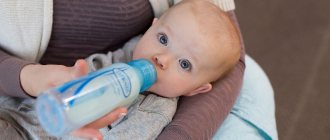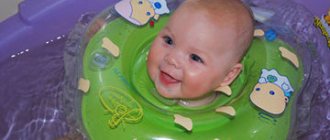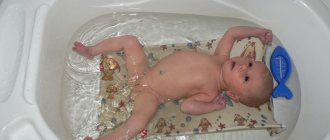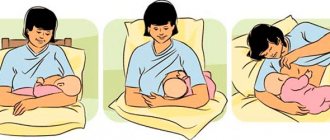Where and with what to wash?
The best place to wash the faucet is above a sink or bathtub with a running stream of warm water, as you can see in the video. If conditions do not allow providing everything necessary for such washing, a similar technique is performed in a basin or bathtub. However, washing in dishes is undesirable, since feces will fall from the water back onto the child’s skin and can cause an inflammatory process.
If you don’t have warm water from the tap, you can ask a relative to pour pre-prepared warm water over a basin, and you can wash the baby.
The washing technique involves using only baby soap. No gels or other fancy products are needed. They can irritate the skin and cause allergies and disrupt the microflora of the genital organs. It is also undesirable to use wet wipes, especially those containing alcohol. They will not be able to provide complete hygiene, and skin irritation may well occur from them. And even more so, you can’t use products for adults. Gels and soaps for adults have a more acidic environment, while for children it is more alkaline.
The water temperature for washing should be about 37 degrees. It is considered the most comfortable for the baby. To measure temperature, use a water thermometer.
The need for newborn hygiene
Newborns need special hygiene. Their skin is very thin and delicate, so prolonged exposure to pollution often causes irritation and inflammation. Based on the fact that newborn children do not run around the streets, there is practically no contamination on their skin except waste products and milk, so babies do not need washcloths and sponges.
Everything you need to wash your newborn:
- warm water;
- baby soap;
- baby towel;
- baby cream
It is very important to pay attention not only to the obviously dirty areas under the diaper, but also to the areas on the neck. The folds between the chin and neck very often accumulate milk that the baby has burped or spilled. Due to the abundance of folds on the baby's body, it is easy for such contaminants to hide from the watchful eye of the mother.
Important! If you do not wash the folds, bacteria develop very quickly in them, which causes an unpleasant odor, redness and pain.
Bath towel
The child must have his own towel, which no one else will use except him. It is better if it is large with a hood. It will last longer, and it will be easier for them to dry the baby after bathing. To wash your baby, it is better to have a separate small towel that absorbs well and is soft to the touch.
How to hold a newborn?
When you have decided where and how to wash your newborn, it’s time to think about the technique of this process. The washing algorithm is as follows (see video):
- In the maternity hospital, the baby is usually in diapers. To clean your baby, you need to place him on a changing table covered with a diaper and remove the diaper. The same technique can be used at home.
- Since in the first days the child has thick, dark stool, it is correct to use warm running water. The baby can get dirty not only the genitals, but also other parts of the body.
- We place the baby on the palm so that he is on it with his back up. The index and middle fingers should be between the baby's body.
- Gently wash the baby with your right hand. Correctly perform hand movements from front to back. This technique will prevent infection from entering the genitals.
- When washing under running water, the process technique allows you to use napkins or a cotton swab. This measure allows you to wash the perineum, which is difficult to achieve if you wash a newborn with your hand.
However, holding the newborn correctly when washing is not enough. You need to know that there are differences in how to wash and hold girls or boys.
Caring for a newborn baby
What does child care involve in the maternity hospital?
Undoubtedly, the baby, who was in his mother’s tummy for all nine months and heard her heartbeat, will be more comfortable with his mother after birth. At the first request, he will be fed, lulled and cuddled, the child will be calmer, and the mother will establish lactation.
And in order for the mother to feel more confident, she needs to prepare for this long-awaited meeting with the baby.
If you have already decided on a maternity hospital, then you need to familiarize yourself with some rules so that caring for a newborn in a maternity hospital is at least theoretically familiar to you.
Most mothers go through the “mother and baby” ward after giving birth. The presence of mother and child together in the maternity hospital has a beneficial effect on both the mother and her baby. In order for this period to be completed successfully, it is useful for every mother to know some rules for caring for a child .
How to hold a newborn baby correctly?
The first thing you need to pay attention to is do not be afraid to touch the baby, the more contact the newborn has with his mother, the better for his development. Naturally, confidence will come with experience, but try to at least tune in, which is also important.
When you take the baby in your arms, try to keep your movements gentle and measured and calm, talk to the baby, smile at him. Although newborn babies still see and hear very poorly, they feel their mother’s mood very well.
Show your love for your baby through touch, and it’s quite possible that your baby will give you his smile already in the maternity hospital.
Try to take your baby calmer and more tenderly, talk to him affectionately, call him by name, smile more often. When you pick up a baby, be sure to support his head, since the newborn's neck muscles are not yet developed and the baby cannot hold his head.
Place one hand under your baby's neck (with his head in the crook of your elbow), and the other under his buttocks. Use your free hand to support your baby's back and buttocks.
Mandatory rule: you need to carry the child on different sides (change left and right hands).
How to position a newborn correctly?
If you need to put your newborn back in the crib, hold him close to you and get as low as possible into the crib with him. Place the baby carefully in the crib, but do not rush to remove your hands.
Wait for him to get used to the hard surface for at least five seconds. Then slowly remove your hands and quickly cover the baby with a blanket to keep warm.
Caring for baby's skin and mucous membranes
In the maternity hospital, a nurse takes care of the skin of a newborn. The processing is carried out in the presence of the mother, so that it is easier for her to do it at home.
The skin of a newborn is delicate, easily vulnerable, and its protective properties are not yet mature enough. Therefore, for a child, especially the first days of life, proper care and cleanliness in everything that surrounds him is necessary. Every morning, the baby is given a morning toilet - washing, caring for the eyes, nose, ears, and natural folds. It is best to do it before the second feeding, at 8-9 am. Morning procedures are usually carried out on a changing table covered with a clean diaper. Using a sterile cotton swab dipped in warm water (36-37°C - this water temperature corresponds to body temperature, this is what you need to be guided by when turning on the water in the tap), wipe the child’s face and hands, then dry them with clean gauze (or disposable paper) soft cloth. The eyes are washed from the outer to the inner corner with a separate swab for each eye. The ears are wiped with cotton balls. Never use cotton swabs, as you may accidentally damage the eardrum (in newborns, the ear canals are wide and short, the eardrum is quite close). The nasal passages are cleaned with cotton flagella twisted from cotton wool (the thickness of the flagellum is 3-5 mm in diameter, length 3-5 cm), each half of the nose is cleaned with a separate flagellum. If there are dry crusts in the nose, the flagellum is moistened with sterile or special baby oil. The child’s morning toilet routine ends with washing and lubricating the folds with a special baby cream or powder.
Caring for the umbilical wound
Treat the umbilical wound after bathing until the umbilical wound is epithelized.
Treat the umbilical wound with diamond green using a cotton swab.
Washing the baby
The child must be washed after each bowel movement. Previously, it was believed that girls and boys should be washed differently (for girls, strictly from front to back). However, doctors have now concluded that to reduce the risk of infection, boys' genitals should be washed in the same way. So, it is recommended to wash all babies with running water from a tap with the water temperature adjusted to the required temperature (37°C) from front to back. When washing, the mother holds the baby, tummy up, on the forearm of her left hand (the baby’s head is in the area of the mother’s elbow, and the thigh is supported by the hand), and washes it with her right hand. In this case, water from the tap first flows onto the mother’s hand, which makes it possible to prevent excessively hot or cold water from getting on the baby’s skin. It is recommended to use baby soap no more than 1-2 times a day; with more frequent use, it washes away the protective fatty lubricant, dries the skin and disrupts its functions. When it is not possible to wash your baby, you can use baby wet sanitary wipes. After washing, you must carefully (using blotting movements) dry the genital area with a clean diaper and lubricate it with baby cream or use baby powder. Don’t forget also about the air bath: let the child lie undressed for 1-2 minutes so that the skin can “breathe”, then you can put a disposable diaper on the baby.
Changing a diaper
Your child's disposable diapers should be changed as they become soiled, but at least every 4 hours, as well as before bed, during a walk, and after bowel movements. The diaper must be the right size, preferably breathable. Technique for changing a disposable diaper:
- Unwaddle the baby lying on his back, unfasten and unfold the used diaper. Remove it by carefully lifting the baby by the legs with one hand and removing the diaper with the other;
- Wash the baby and apply cream as described above;
- Take a clean diaper and lay it out. Lift your baby slightly by the legs and place a diaper under his bottom. The colored strip with a pattern should be on the front, the part with Velcro should be on the back. The top edge of the back of the diaper should be on the baby's back in the lumbar area. Pull the front of the diaper up and place it over your baby's tummy. Fasten the diaper, first straightening the cuffs. Check how tightly it fits to the body (your finger should fit between the belt and the child’s body, otherwise the blood supply will be disrupted). Since his umbilical wound has not yet healed, the diaper band should be folded outward to allow air circulation.
How to swaddle a newborn.
In the maternity hospital, the nurse will show you how to properly swaddle a newborn. To ensure everything works out well for you, first practice at home on a doll, just keep in mind that the baby will not lie as calmly. Therefore, try to learn how to swaddle more quickly, otherwise the baby will have time to get rid of the diaper.
Currently, loose swaddling is recommended, in which the baby can move his legs and take a position that is comfortable for him. During the first 2-3 days, the arms are covered when swaddling; later, the arms are left free. It is not necessary for newborns to wear a cap (at home, wear it only after bathing if the room temperature is below 22°C).
We sincerely hope that the above tips for caring for a child in the maternity hospital will help every mother and allow her to feel more confident when caring for her baby.
Now experts are in favor of placing the baby first on the mother’s stomach after birth, for early breastfeeding, for the baby to stay together with the mother, for free swaddling, and for feeding at the child’s request.
Algorithm for girls
It is much more difficult to wash girls properly than boys, as can be seen in the video. Girls should be held in the same way as boys, but they should be washed correctly from the bottom up. This is due to the structural features of the genital organs and urinary system. Girls' bladders are wider and therefore more susceptible to infection.
In girls, vernix must be washed off very carefully. If you do not hold your newborn correctly when washing, or try to make do with napkins instead of running water, the lubricant will dry out and subsequently cause synechiae and fusion of the labia. To prevent this from happening, wash the folds thoroughly.
Features of a boy
The situation with boys is much easier. This can be seen in the video. It is enough to hold the newborn correctly when washing. You can wash the boy either from the bottom up or from the top down, but it is correct to stick to the first option.
Parents should take note that they should not retract the foreskin unnecessarily: you can easily damage it. She can move away only when she is three years old. If this does not happen, you need to consult a doctor.
Any parent can properly hold and wash a newborn. An educational video will help you with this, where you can see in detail how to wash a newborn.











